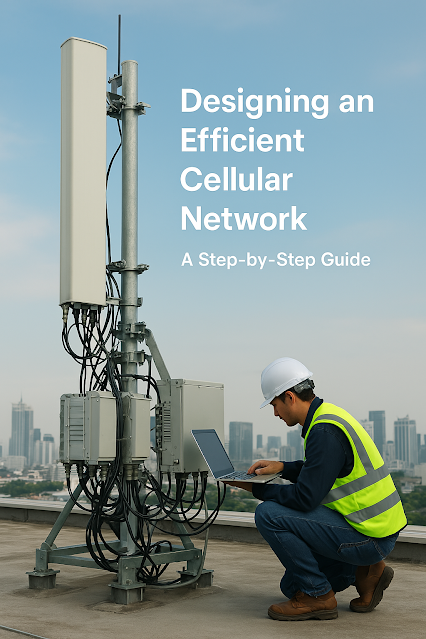This article provides a step-by-step technical guide to designing an efficient cellular network, covering essential planning principles, tools, and techniques, followed by answers to frequently asked questions.
1. Understand the Key Objectives
The two primary goals in cellular network design are:
-
Coverage: Ensuring signal strength reaches all users in the area, with minimal dead zones.
-
Capacity: Ensuring sufficient bandwidth to serve the expected number of users with good quality of service (QoS).
These must be balanced carefully—improving one can often compromise the other.
2. Gather Site-Specific Information
Before any design begins, you need to collect the following:
-
Topographical Data: Terrain elevation, vegetation, and building data.
-
Demographics & Traffic Data: User density, peak usage times, mobility patterns.
-
Spectrum Availability: Frequency bands licensed to the operator.
-
Regulatory Constraints: Tower height limits, EMF exposure limits, zoning restrictions.
3. Choose Appropriate Frequency Bands
-
Low-band (e.g., 700–900 MHz): Excellent for wide coverage and indoor penetration, but offers lower capacity.
-
Mid-band (1.8–3.5 GHz): Good balance of coverage and capacity. Widely used in LTE and 5G.
-
High-band (mmWave, >24 GHz): Supports high capacity, but with limited range and poor penetration.
Tip: Use a multi-band approach for optimal performance.
4. Perform Link Budget Analysis
A link budget estimates the received signal power at the user equipment (UE), accounting for gains and losses along the path:
Where:
-
= Received power
-
= Transmit power
-
, = Transmit/receive antenna gains
-
= Path loss
-
= Fading/margin losses
-
= Miscellaneous losses (cable, connector, etc.)
A positive link budget ensures good coverage.
5. Determine Cell Radius and Site Count
Based on the path loss model (e.g., Hata, Okumura, COST231), calculate the maximum allowable distance from the base station (BS) where signal quality remains acceptable. This gives you the cell radius.
Then, calculate the number of sites:
Where:
-
= number of cells
-
= total area to cover
-
= cell radius
Note: Apply a hexagonal layout for uniform coverage and efficient frequency reuse.
6. Apply Frequency Reuse and Interference Planning
To increase capacity while minimizing co-channel interference (CCI):
-
Use frequency reuse patterns (e.g., 3, 7, or 12-cell clusters).
-
Implement frequency planning for GSM or inter-cell interference coordination (ICIC) for LTE/5G.
-
In high-density areas, consider sectorization (dividing a site into 3 or 6 sectors using directional antennas).
7. Plan for Capacity
Capacity depends on:
-
Bandwidth available
-
Spectral efficiency (bps/Hz/cell)
-
Number of sectors and cells
-
User behavior (data consumption per user)
Use the Erlang B model for voice capacity, and Shannon’s theorem or actual throughput metrics for data capacity planning.
Also factor in:
-
MIMO configuration (2x2, 4x4, 8x8)
-
User density and distribution
-
Backhaul capacity (fiber or microwave)
8. Run Simulations
Use radio network planning tools (e.g., Atoll, Planet, iBwave) to:
-
Simulate signal strength (RSRP, SINR)
-
Identify coverage holes and overlaps
-
Validate handover zones
-
Predict user throughput and blocking probabilities
Tuning parameters like antenna tilt, azimuth, and power levels helps fine-tune coverage and capacity.
9. Optimize and Iterate
Post-simulation:
-
Optimize using drive test data
-
Tweak antenna parameters and power settings
-
Add small cells, repeaters, or DAS in weak areas
-
Perform load balancing and mobility tuning
10. Future-Proof the Network
Design with scalability in mind:
-
Use modular backhaul that supports 5G upgrades
-
Keep space for adding more sectors or small cells
-
Ensure compatibility with network virtualization, edge computing, and open RAN for 6G readiness
Frequently Asked Questions (FAQs)
Q1: What is the ideal cell radius in urban areas?
A: Typically 0.5–2 km, depending on frequency band, building density, and user load.
Q2: How do I choose between macro and small cells?
A: Use macro cells for wide-area coverage, and small cells (micro/pico/femto) for high-capacity zones like malls, stadiums, or dense urban areas.
Q3: What’s more important—coverage or capacity?
A: Both are critical. For rural areas, prioritize coverage. For cities, capacity is often the limiting factor due to high user density.
Q4: Can 5G replace all previous generations?
A: Not yet. 5G complements 4G and 3G in most deployments. In many areas, 4G provides coverage, while 5G offers capacity.
Q5: How do terrain and buildings affect coverage?
A: Obstacles cause signal attenuation and multipath fading. Use terrain-aware planning and consider LOS (Line of Sight) for high frequencies.
Conclusion
Designing a cellular network is a multidisciplinary task that blends RF engineering, data analytics, and simulation tools. By carefully balancing coverage and capacity, and using the right technologies, you can ensure a reliable and scalable network infrastructure that meets user expectations today—and tomorrow.
